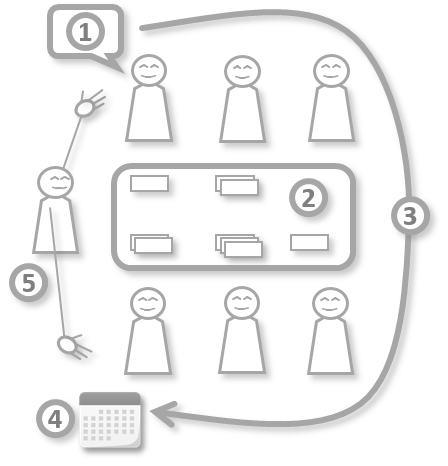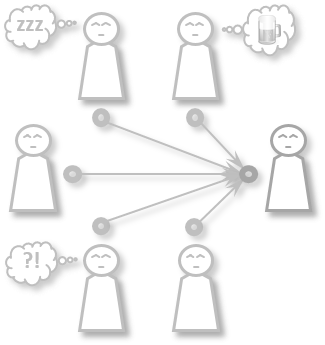You know how it goes. There is a group of coworkers round the table and they report one after another project status to their manager. Everyone should be interested in work of others but the truth is they just wait for their turn to say their part. The only person who is somehow satisfied in the end is the manager who just got information about project status. Everyone else hates this meeting or at least takes it as necessary evil. Is it possible to do it a better way?
Imagine people really looking forward to that meeting. Imagine people perceiving the meeting as a key part of their work; as a meeting that helps them very quickly, efficiently and collaboratively solve their operational issues. And imagine a meeting that convinces everyone the project continues as fast and right as possible.
How? Instead of reporting status let’s share what we do and miss and then solve issues in pairs based on actual needs – the same way businessmen do their business in 21st century.
How does it work?
First, the focus is moved from “where we were last week/month” to “what we need to move forward as quickly as possible”. Second, the project team works autonomously and the manager, instead of being a micro-controller, becomes a guardian of team values and boundaries of team autonomy, and an active supporter of project activities.
Meeting agenda
 Each and every participant gives 1-2 minute elevator speech:
Each and every participant gives 1-2 minute elevator speech:- Who I am and what I do (can be reduced or skipped if people know each other well already)
- What we succeeded in since the last meeting and what I can help others with.
- What I struggle and need help with
- Other participants listen to the speech and do their best to help the speaker. They typically offer either their help or contacts in their network who can help. In both cases they do not say anything aloud, they just fill in a referral sheet immediately at the moment they see the opportunity to help. They do it immediately because we usually do not remember much after all the participants give their speech 🙂 The participants fill in a referral sheet also at the moment they want to accept offered help or they just simply want to know more about the shared topic.
- After the round ends, the participants pass their referral sheets to each other. This exchange visualizes all the connections and makes them conscious. There is also kind of psychological effect of accepting offered referral sheet as a gift, as a certain form of commitment. This increases likeliness of subsequent meeting and cooperation.
- After the referral sheets are exchanged the participants open their calendars and immediately plan meetings to share or help each other. A planned meeting in a calendar once again raises the chance the follow-up really happens afterwards.
- The leader of the meeting encourages the participants to connect and pair during the meeting. And s/he actively offers his/her help and network.
The leader and all the participants get synchronized about what is going on in the project and what are the current obstacles. Moreover they actively help each other to go further with the project.
What do we need?
1, Focus on future
Project has to have clearly defined goal (overall goal and the closest milestone) including acceptance criteria. Each and every project member knows answer to questions “What is a good result of the project?” (goals) and “How do we know we are there already?” (acceptance criteria, KPIs). Just go and ask randomly selected team member whether s/he can instantly answer these questions. If not – you know what to do 🙂
2, Autonomous team
Team members (or a team of teams) usually work independently. But hidden potential lays between the units, in collaboration: 1+1=11. When everyone understands the goals and the definition of done then the best way to create really collaborating team is to pair individual members to solve (non-trivial) problems in order to reach the goals. This way we build so called Triades (see Tribal leadership). By working in pairs they shorten work lead time, less likely introduce an error, learn from each other and become substitutable and they also build and strengthen their relations. Eventually, in the course of time we transform individualities to a collaborating autonomous team. You might then see teams, which did not talk to each other earlier, discussing and proactively solving project issues by a coffee machine.
3, Manager = Leader
The leader is the key part of the system. From the original control element s/he becomes a connector and supporting element. His/her most important role is to support team members pairing and to make sure everyone knows answers to the questions above. The leader then proactively removes obstacles that team cannot remove by itself and regularly “changes oil” by organizing regular team retrospectives – meetings where team members discuss what works well and should become a standard way of working and also what to improve. One and only one improvement is then taken into action and implemented as quickly as possible. We take just one and only improvement because we know from experience the more parallel work we start the less chance is to finish anything at all.

Positive side effects
Established relationships and the habit of working in pairs pays off heavily later on when something unexpected happens (which actually happens every day 🙂 When people are used to work together and they know and trust each other they would most likely proactively solve issues together rather than set borders and blame each other.
We know each project is unique, would you share your story with us? – contact.us@rainfellows.com.

